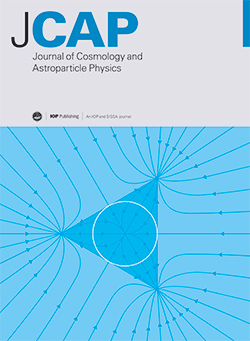Search for quantum decoherence in neutrino oscillations with six detection units of KM3NeT/ORCA
IF 5.3
2区 物理与天体物理
Q1 ASTRONOMY & ASTROPHYSICS
Journal of Cosmology and Astroparticle Physics
Pub Date : 2025-03-20
DOI:10.1088/1475-7516/2025/03/039
引用次数: 0
Abstract
Neutrinos described as an open quantum system may interact with the environment which introduces stochastic perturbations to their quantum phase. This mechanism leads to a loss of coherence along the propagation of the neutrino - a phenomenon commonly referred to as decoherence - and ultimately, to a modification of the oscillation probabilities. Fluctuations in space-time, as envisaged by various theories of quantum gravity, are a potential candidate for a decoherence-inducing environment. Consequently, the search for decoherence provides a rare opportunity to investigate quantum gravitational effects which are usually beyond the reach of current experiments. In this work, quantum decoherence effects are searched for in neutrino data collected by the KM3NeT/ORCA detector from January 2020 to November 2021. The analysis focuses on atmospheric neutrinos within the energy range of a few GeV to 100 GeV. Adopting the open quantum system framework, decoherence is described in a phenomenological manner with the strength of the effect given by the parameters Γ21 and Γ31. Following previous studies, a dependence of the type Γij ∝ (E/E0)n on the neutrino energy is assumed and the cases n = -2,-1 are explored. No significant deviation with respect to the standard oscillation hypothesis is observed. Therefore, 90% CL upper limits are estimated as Γ21 < 4.6· 1021GeV and Γ31 < 8.4· 1021GeV for n = -2 and Γ21 < 1.9· 10-22GeV and Γ31 < 2.7· 10-22GeV for n = -1, respectively.求助全文
约1分钟内获得全文
求助全文
来源期刊

Journal of Cosmology and Astroparticle Physics
地学天文-天文与天体物理
CiteScore
10.20
自引率
23.40%
发文量
632
审稿时长
1 months
期刊介绍:
Journal of Cosmology and Astroparticle Physics (JCAP) encompasses theoretical, observational and experimental areas as well as computation and simulation. The journal covers the latest developments in the theory of all fundamental interactions and their cosmological implications (e.g. M-theory and cosmology, brane cosmology). JCAP''s coverage also includes topics such as formation, dynamics and clustering of galaxies, pre-galactic star formation, x-ray astronomy, radio astronomy, gravitational lensing, active galactic nuclei, intergalactic and interstellar matter.
 求助内容:
求助内容: 应助结果提醒方式:
应助结果提醒方式:


